How to buy a torque wrench
How to buy a torque wrench
Many DIYers ignore the need to use a torque wrench on fasteners and as a result they often overtighten and strips components, studs and threads in aluminum cylinder heads and engines. That’s a HUGE mistake. You create more problem by not using a torque wrench. Here’s how to buy a torque wrench.
Plus, many of the newer fasteners are either “prevailing torque” or “torque-to-yield” types that must be tightened exactly to the proper torque and torque angle. Failure to follow the manufacturer’s directions can cause the fastener to fail.
There are 4 types of torque wrenches — pros can cons of each
The oldest is the beam style torque wrench
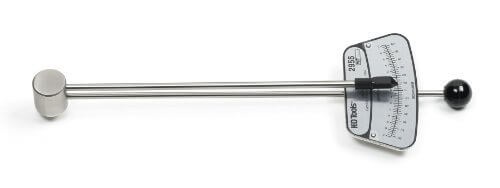
Bending beam style torque wrench
The least expensive of the five types, the beam style wrench never requires re-calibration. A beam style wrench includes a torque scale and a pointer. As you tighten the bolt, the twist causes the pointer to move along the scale.
Pros: Cheap
Cons: 1) The biggest problem with a beam style torque wrench is that the dial might not be in your line of sight as you tighten the bolt.
2) It’s harder to read the scale to a precise level
Rotary Dial wrench
Pro: Dial torque wrenches are more accurate than either
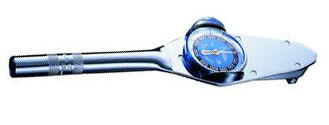
Dial torque wrench
beam or clicker style wrenches
Con: They’re also more expensive and sometimes the dial isn’t in your field of view.
Clicker – micrometer style torque wrench.
These are the most common. Prices range from as little as $25 for economy wrenches to around $150 for precision instruments. The economy clicker style

Economy clicker style torque wrench
wrenches are better than using no torque wrench at all but are notoriously unreliable over the long term. They’re made from low quality components and tend to lose their calibration quickly. Worse yet, most calibration/repair firms refuse won’t work on them because they can’t get parts. Plus, repair shops find that these economy wrenches lose their calibration rapidly and shops don’t want the liability for any damage caused by that rapid de-calibration.
Premium quality clicker style wrenches are more expensive, but more accurate and they hold their calibration much longer. They can be repaired and re calibrated by any reputable repair shop

Central Tools #97351 micrometer clicker style torque wrench
Digital Torque Wrench
The most costly and accuracy is dependent on the brand.

CDI 2401CI3 Drive Computorq digital torque wrench
However, once properly calibrated, they tend to hold their calibration for long periods. They must be stored in controlled temperature conditions because wide temperature swings affect the digital sensors.
Digital torque adapter
These aren’t wrenches at all. They snap onto any ordinary ratchet and
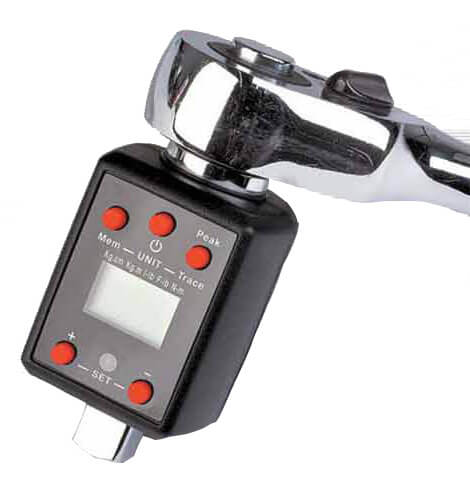
Alltrade 940759 Powerbuilt Digital Torque adapter
simple supply a visual and audible signal when you reached the set torque. In addition to acting like a torque wrench when tightening bolts, you can also use a digital torque adapter to calibrate a clicker or dial wrench. Simply lock the adapter in a vice and set the desired calibration torque. Use your click or dial wrench to the hex head and note how much adjustment the clicker or dial wrench requires. Make the adjustment and then re-test.
You can buy a torque wrench that works and meets your budget
Economy clicker torque wrenches and digital adapters work well enough for most DIY projects. However, neither should be relied on if you’re doing precise engine work like engine rebuilding.
How to prepare the bolt threads before torquing with a torque wrench
Unless otherwise specified by the carmaker, all torque specifications are based on a bolt having clean, dry, undamaged threads. Since the torque setting is a based on friction between the bolt head and the component, adding a lubricant is never proper unless specifically required in the shop manual. Lubricating the threads when not required skews the bolt torque, causing bolt overtightening. If you add thread lubricant, you must reduce the torque setting by around 10%.
Example: Spark plugs must be tightened with a torque wrench
I don’t care how long you’ve been installing spark plug in engines. If you don’t use a torque wrench on these newer aluminum cylinder heads, you’re just begging for trouble—BIG trouble. The torque spec for spark plugs in an aluminum head is between eight and 17-ft/.bs. That’s not a lot of torque. In fact, most home DIYers don’t own a torque wrench that goes down to 8-ft/lbs. If you tighten your spark plugs without a torque wrench, chances are you’ll overtighten the plug.
Overtightening a spark plug damaged the aluminum threads. The extra torque can cause the threads to roll-over and make it hard to remove the plug down the road. Or, worse yet, over tightening can literally rip the threads right out of the cylinder head as it heats up. Plus,
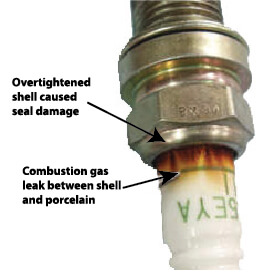
Over tightened spark plug leaks between shell and porcelain. Over tightening damaged the seal
overtightening the spark plug causes the plug’s steel shell to distort, causing a seal leak between the steel shell and the porcelain. That causes combustion gas leaks and misfires and in extreme cases can literally blow the spark plug boot off the plug.
Under tightening the spark plug also causes combustion gas leaks and spark plug overheat, causing misfires and carbon buildup in the threads which makes it almost impossible to remove the plug later. Plus, the loose plug can blow out of the cylinder head, taking the cylinder head threads with it.
Follow the bolt tightening sequence. Cylinder head, manifolds and oil pans require a specific bolt tightening pattern to avoid component distortion. In most cases the bolt tightening pattern starts in the middle of the component with alternating patterns radiating out toward the ends.
How to tighten a bolt using a torque wrench
If you’re tightening traditional bolts (not TTY bolts), use one of these two methods.
Two-step Method 1: Set the torque wrench to one-half the specified torque (clicker, digital and micrometer style wrenches). Tighten the bolt to that spec. Let the bolt relax for about 30-secs. while you reset the wrench to the final torque specification. Then torque the bolt to the final spec. The two –step method provides the most accuracy since it allows the bolt time to stretch slightly before applying the final torque.
One-step method: Set the specified torque and tighten the bolt until you feel a click or digital alert or the torque reaches the set amount on the dial.
How to tighten torque to yield (TTY) bolts
TTY bolts are single use bolts that are designed to stretch a certain
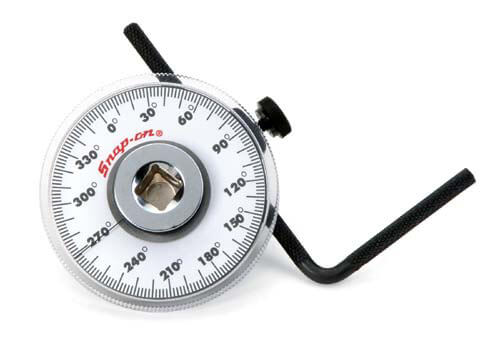
Torque angle gauge for TTY bolts
amount before they reach full clamping power. The torque sequence usually involves torqueing the bolt in stages, sometimes as many as five steps with varying torque wrench setting at each stage, followed by turning the bolt head a certain number of degrees using a torque angle gauge.
Prepare the component threads before starting TTY bolts. Use a thread chaser to clean any rust or debris from the threaded component to get the most accurate final torque.
NEVER re-use a TTY fastener
Never re-use a prevailing torque fastener. For more information on prevailing torque fasteners, see this post.
How to hold a torque wrench.
The torque values are calculated based applying force to the handle area of the wrench. If you hold the wrench anywhere else but the handle, you risk over or under-tightening the fastener.
Which torque wrench to buy?
Economy torque wrenches from China and other offshore companies have flooded the market over the past decade. These wrenches are cheap and similar in appearance to premium quality wrenches, but they’re nowhere near the same quality. They don’t hold their calibration very long and are difficult, if not impossible to re-calibrate. Most torque wrench repair shops won’t repair or recalibrate them.
An economy torque wrench can do an ok job on lug nuts or intake manifolds, but shouldn’t be used for cylinder head or other highly precise jobs. They’re better than not using a torque wrench at all, but shouldn’t be mistaken for a precision instrument.
Bending beam and clicker wrenches are the most popular for home DIY. Central Tools, Snap-on, Precision Instruments, Proto, and Gear Wrench are all quality brands.
Torque wrench mistakes
Never use a torque wrench as a breaker bar.
A torque wrench with a high torque range usually has a long handle. When home DIYers run into a stubborn bolt that requires more leverage, they often reach for their long handled torque wrench. BIG mistake. Using a torque wrench instead of a breaker bar to loosen a stuck bolt is a great way damage or knock your torque wrench out of calibration.
Always unload your torque wrench before storing it.
Clicker style torque wrenches use a calibration spring that must be unloaded before storing to avoid mis-calibration issues down the road. Dial the micrometer setting to zero (never below 0) before storing.
Store your torque wrench in a temperature controlled setting
Clicker, dial and beam bending wrenches can provide improper torque values if they’re not at the same room temperature as the fastener. If you store your tools in an unheated garage and heat your garage when you work on your vehicle, allow your torque wrench to reach room temperature before using.
©, 2017 Rick Muscoplat
Posted on by Rick Muscoplat
